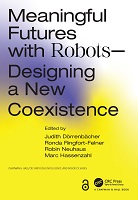Chapter 3 How to Design Robots with Superpowers
Proposal review
| dc.contributor.author | Neuhaus, Robin | |
| dc.contributor.author | Ringfort-Felner, Ronda | |
| dc.contributor.author | Dörrenbächer, Judith | |
| dc.contributor.author | Hassenzahl, Marc | |
| dc.date.accessioned | 2022-11-16T10:18:43Z | |
| dc.date.available | 2022-11-16T10:18:43Z | |
| dc.date.issued | 2023 | |
| dc.identifier.uri | https://library.oapen.org/handle/20.500.12657/59256 | |
| dc.description.abstract | Robots are often designed to increase efficiency. They are typically positioned in a particular field of application to replace humans, making someone’s work obsolete. But robots are able to complement the humans they work with through collaboration and the incorporation of the psychological strengths that robots can have in social situations. This chapter presents a co-design method based on a possibility-driven design approach and “robotic superpowers” (a concept that originated from Welge, Hassenzahl, Dörrenbächer and colleagues). Social robots can offer new, positive experiences and constructively impact work practices that incorporate their social strengths, such as endless patience or unbiased selection. To that end, the chapter describes a three-step design process by collecting existing work practices, defining scenario-specific robotic superpowers, and developing concepts for future robots. To illustrate possible outcomes, the authors showcase several exemplary concepts created using this new process. | en_US |
| dc.language | English | en_US |
| dc.subject.classification | thema EDItEUR::U Computing and Information Technology | en_US |
| dc.subject.classification | thema EDItEUR::T Technology, Engineering, Agriculture, Industrial processes::TJ Electronics and communications engineering::TJF Electronics engineering::TJFM Automatic control engineering::TJFM1 Robotics | en_US |
| dc.subject.classification | thema EDItEUR::U Computing and Information Technology::UY Computer science::UYZ Human–computer interaction | en_US |
| dc.subject.other | a, aI, Coexistence, Designing, Dorrenbacher, Dörrenbächer, et, Felner, Futures, Hassenzahl, Judith, Marc, Meaningful, Neuhaus, New, Ringfort, Robin, Robots, Ronda | en_US |
| dc.title | Chapter 3 How to Design Robots with Superpowers | en_US |
| dc.type | chapter | |
| oapen.identifier.doi | 10.1201/9781003287445-3 | en_US |
| oapen.relation.isPublishedBy | 7b3c7b10-5b1e-40b3-860e-c6dd5197f0bb | en_US |
| oapen.relation.isPartOfBook | 17bfd2cb-2e5a-4b89-8f97-bb379c40c420 | en_US |
| oapen.relation.isbn | 9781032262673 | en_US |
| oapen.relation.isbn | 9781032246482 | en_US |
| oapen.imprint | CRC Press | en_US |
| oapen.pages | 12 | en_US |
| peerreview.anonymity | Single-anonymised | |
| peerreview.id | bc80075c-96cc-4740-a9f3-a234bc2598f1 | |
| peerreview.open.review | No | |
| peerreview.publish.responsibility | Publisher | |
| peerreview.review.stage | Pre-publication | |
| peerreview.review.type | Proposal | |
| peerreview.reviewer.type | Internal editor | |
| peerreview.reviewer.type | External peer reviewer | |
| peerreview.title | Proposal review | |
| oapen.review.comments | Taylor & Francis open access titles are reviewed as a minimum at proposal stage by at least two external peer reviewers and an internal editor (additional reviews may be sought and additional content reviewed as required). |

